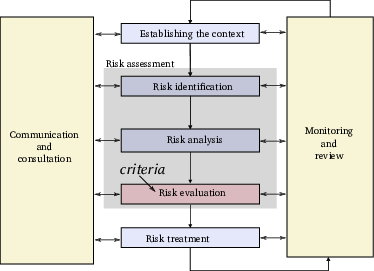Risk acceptability and tolerability
Overview

Risk acceptance criteria are standards of judging used as a basis for decisions about acceptable risk, during the risk evaluation phase of risk analysis. Indeed, risk evaluation consists of comparing risk analysis results with risk criteria in order to determine whether or not a specified level of risk is acceptable or tolerable.
These slides develop the distinction between acceptability and tolerability of risks, describe the factors that influence acceptability, and outline a number of decision rules used in various industrial sectors to determine which levels of risk are acceptable (absolute targets, ALARP principle, GAME, etc.).
This submodule is a part of the risk management module.
Course material
 |
Risk acceptability and tolerability |
Some example decision rules on risk acceptance:
The ALARP or “as low as reasonable practicable” principle. A lot of discussion revolves around the interpretation of the term “reasonably”, which is inherently sector-dependent and somewhat subjective. Techniques used to interpret “reasonably practicable” include referring to industry standards and good practice, and using benefit-cost analysis with a “gross disproportion factor”.
The Minimum Endogenous Mortality (MEM) rule, which states that a new system should not lead to a significant increase in the risk exposure for the population with the lowest endogenous mortality. The rate of natural deaths is then a reference point for acceptability.
The «Globalement au Moins Équivalent» (GAME) rule used in French railways states that “all new guided transport systems must offer a level of risk globally at least as good as the one offered by any equivalent system”. For instance the Channel Tunnel Safety Authority imposed a requirement that the safety performance of the tunnel between the UK and France should be no worse than that of a surface railway of similar length. This rule requires an existing system which can act as the reference.
The Best Available Technology or BAT rule is a regulatory principle which is widely used to control environmental risks, in particular industrial emissions. It requires operating companies to use techniques or technologies that are recognized as being the best available and are economically and technically viable (that can be deployed without requiring “excessive” costs). Lists of “best available” technologies are published under the auspices of the regulator based on discussions within industry working groups.
The precautionary principle states (in the version prepared during the 1992 Rio summit) that “Where there are threats of serious or irreversible environmental damage, lack of full scientific certainty shall not be used as a reason for postponing cost effective measures to prevent environmental degradation”. A simpler way of expressing the principle is that incomplete scientific knowledge should not be an excuse for regulatory inertia. This principle and its interpretation have been widely debated over the past three decades.
Other resources
We recommend the following sources of further information on this topic:
Reducing risk, protecting people: HSE’s decision-making process, UK Health and Safety Executive, 2001
Report Exploring Risk Appetite and Risk Tolerance by the Risk and Insurance Management Society (RIMS), 2012
Published:
Last updated: